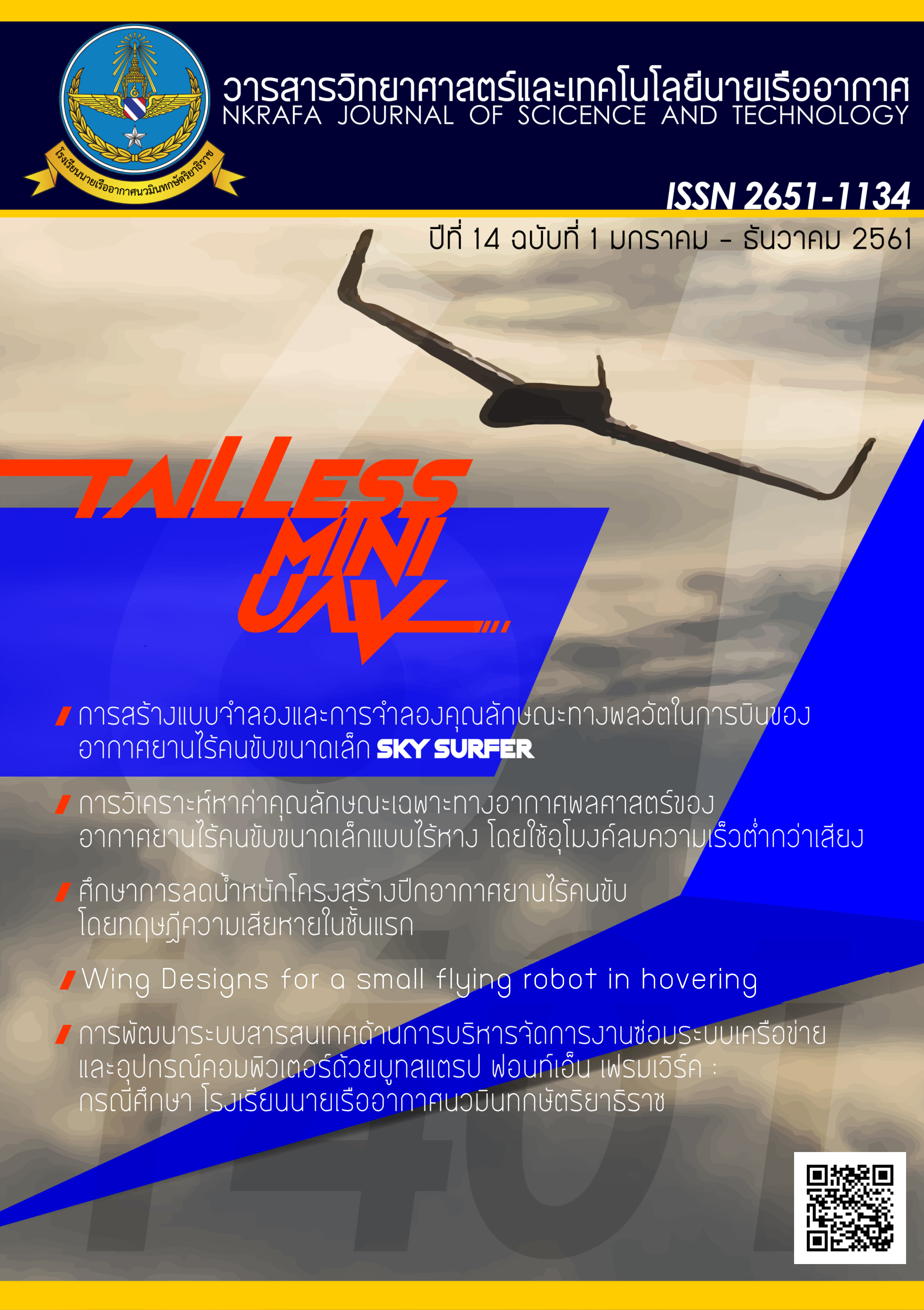Wing Designs for a small flying robot in hovering
Main Article Content
Abstract
Micro Aerial Vehicle (MAV) technology is currently interesting since it can be applied extensively such as hazardous to mankind environment. Therefore, we are interested in the study of the MAV wing designs and the flapping mechanisms. Specifically, three wings has been designed using cloth fabric and a plastic sheet. The Clap-and-Fling, imitating an insect flight mechanism, is chosen as a main flapping mechanism. The average lift force is measured and processed using load cell and Arduino board, respectively. The results show that the wings in which the upper part are made of cloth fabrics and the lower part are made of plastic sheets with the angle of attack at 75 degree produce the best average lift force equals to 9.047 grams. Since the average lift is greater than zero, the designed mechanism is able to float in the air.
Article Details
- Content and information in articles published in NKRAFA Journal of Science and Technology are comment and responsibility of authors of articles directly. Journal editorial do no need to agree or share any responsibility.
- NKRAFA Journal of Science and Technology Articles holds the copyright of the content, pictures, images etc. which published in it. If any person or agency require to reuse all or some part of articles, the permission must be obtained from the NKRAFA Journal of Science and Technology.
References
Development of the Nano Hummingbird:
A Tailless Flapping Wing Micro Air
Vehicle. 50th AIAA Aerospace Sciences Meeting
including the New Horizons Forum and
Aerospace Exposition.
[2] The Robot Dragonfly. Retrieved on 15 September,
2017, from http://www.techject.com/
[3] BionicOpter-Inspired by dragonfly flight. Retrieved
on 15 September, 2017, from http://www.festo.com
/cms/en_corp/13165.htm
[4] Zdunich, P., Bilyk, D., MacMaster, M., Loewen, D.,
DeLaurier, J., Kornbluh, R., Low, T., Stanford, S.,
and Holeman, D. (2007). Development and testing
of the mentor flapping-wing micro air vehicle.
J. Aircraft, 44(5): 1701–1711.
[5] Delfly Robot. Retrieved on 15 September, 2017,
from www.delfly.nl/home.html.
[6] Richter, C., Lipson, H. (2011). Untethered hovering
flapping flight of a 3D-printed mechanical insect.
Artificial Life, 17: 73–86.
[7] Van Breugel, F., Regan, W., and Lipson, H. (2008).
From insects to machines: A passively stable,
untethered flapping hovering micro-air vehicle.
IEEE Robot. Autom. Mag., 15(4): 68–74.
[8] Ristroph, L., Childress, S. (2014). Stable hovering
of a jellyfish-like flying machine. J. R. Soc.
Interface, 11(92): 20130992.
doi:10.1098/rsif.2013.0992.
[9] Aerovironment. (2009, June 30). AV Achieves
Technical Milestone: controlled hovering flight of
NAV with two flapping wings. Press Release.
Retrieved on 15 September, 2017, from
http://www.avinc.com/downloads/NAVPRLong
DARPAV4.doc.pdf
[10] Weis-Fogh, T. (1975). Unusual mechanisms for
the generation of lift in flying animals. Scient.
Am., 233(5): 80–87.
[11] Dickinson, M. H., Lehmann, F.O., Sane, S.P.
(1999). Wing rotation and the aerodynamic basis
of insect flight. Science, 284(5422): 1954–1960.
[12] Galinski, C., and Zbikowski, R. (2005). Insect-like
flapping wing mechanism based on a double
spherical Scotch yoke. J. R. Soc. Interface, 2(3):
223–235.
[13] Nguyen, Q.V., Park, H.C., Goo, N.S., and Byun,
D.Y. (2010). Characteristics of a beetle’s free
flight and a flapping-wing system that mimics
beetle flight. J. Bionic Engineering, 7(1): 77–86.
[14] M. Naef. (2009). Design of a flapping wing
mechanism. Zurich: Swiss Federal Institute of
Technology Zurich.
[15] Linton, J. Oliver. (2007). The physics of flight: II.
Flapping wings. Physics education, 42(4): 358.

